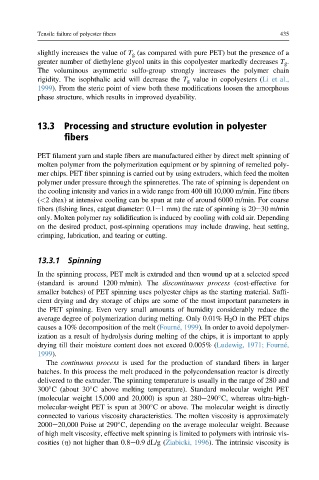Page 462 - Handbook of Properties of Textile and Technical Fibres
P. 462
Tensile failure of polyester fibers 435
slightly increases the value of T g (as compared with pure PET) but the presence of a
greater number of diethylene glycol units in this copolyester markedly decreases T g .
The voluminous asymmetric sulfo-group strongly increases the polymer chain
rigidity. The isophthalic acid will decrease the T g value in copolyesters (Li et al.,
1999). From the steric point of view both these modifications loosen the amorphous
phase structure, which results in improved dyeability.
13.3 Processing and structure evolution in polyester
fibers
PET filament yarn and staple fibers are manufactured either by direct melt spinning of
molten polymer from the polymerization equipment or by spinning of remelted poly-
mer chips. PET fiber spinning is carried out by using extruders, which feed the molten
polymer under pressure through the spinnerettes. The rate of spinning is dependent on
the cooling intensity and varies in a wide range from 400 till 10,000 m/min. Fine fibers
(<2 dtex) at intensive cooling can be spun at rate of around 6000 m/min. For coarse
fibers (fishing lines, catgut diameter: 0.1e1 mm) the rate of spinning is 20e30 m/min
only. Molten polymer ray solidification is induced by cooling with cold air. Depending
on the desired product, post-spinning operations may include drawing, heat setting,
crimping, lubrication, and tearing or cutting.
13.3.1 Spinning
In the spinning process, PET melt is extruded and then wound up at a selected speed
(standard is around 1200 m/min). The discontinuous process (cost-effective for
smaller batches) of PET spinning uses polyester chips as the starting material. Suffi-
cient drying and dry storage of chips are some of the most important parameters in
the PET spinning. Even very small amounts of humidity considerably reduce the
average degree of polymerization during melting. Only 0.01% H 2 O in the PET chips
causes a 10% decomposition of the melt (Fourné, 1999). In order to avoid depolymer-
ization as a result of hydrolysis during melting of the chips, it is important to apply
drying till their moisture content does not exceed 0.005% (Ludewig, 1971; Fourné,
1999).
The continuous process is used for the production of standard fibers in larger
batches. In this process the melt produced in the polycondensation reactor is directly
delivered to the extruder. The spinning temperature is usually in the range of 280 and
300 C (about 30 C above melting temperature). Standard molecular weight PET
(molecular weight 15,000 and 20,000) is spun at 280e290 C, whereas ultra-high-
molecular-weight PET is spun at 300 C or above. The molecular weight is directly
connected to various viscosity characteristics. The molten viscosity is approximately
2000e20,000 Poise at 290 C, depending on the average molecular weight. Because
of high melt viscosity, effective melt spinning is limited to polymers with intrinsic vis-
cosities (h) not higher than 0.8e0.9 dL/g (Ziabicki, 1996). The intrinsic viscosity is

